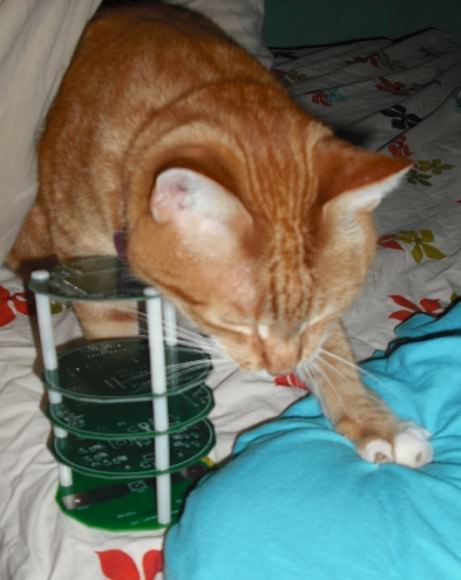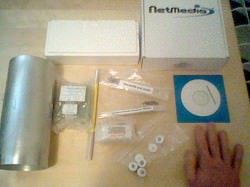[/caption]
For a space geek, the ultimate do-it-yourself project would be building a satellite in your basement. Astronomer and writer Sandy Antunes is doing just that, but there’s an artsy side to this project, as well. His satellite, called Project Calliope, will collect data from the ionosphere and send it back to Earth in sound-based MIDI files, allowing music to be created from space. “It’ll be an ionospheric detector transmitting sonifiable data back to Earth,” said Antunes. “Conceptually, it’s a musical instrument in space, played by space rather than just after-the-fact sonified.”
Antunes decided to embark on this project after the commercial space company InterOrbital began offering small DIY, soda-can-sized picosatellites for the reasonable price of $8,000 – which includes the launch.
One of the major reasons for doing the project is to prove that anyone can build a satellite in their basement – although Antunes admits it is also a fairly cheap midlife crisis expenditure, especially when his boss at the Science 2.0 blog, Hank Campbell, decided to pitch in half of the price.

“When people ask, ‘where did you get your idea?’ that misses the mark,” Antunes told Universe Today. “The question should be, ‘What idea do you have?’ We’re at the point now where a single hobbyist can send something into orbit to do something useful. I think this is a new space age way of thinking. I’d like to see if this inspires people to do something cooler than me. To me that is what science is all about.”
Antunes is documenting his experiences on his blog, The Sky By Day. “I’m making mistakes so that other people won’t have to make them,” he said. “Hopefully I can make the path will be easier for others.”
Plus, Antunes hopes to answer the big question of what space sounds like. The sun interacts with the Earth’s magnetic field in the ionosphere, creating all sorts of activity; there are also changes in temperature and light.
“People don’t know what space sounds like,” he said. “You walk to ocean and close your eyes and you can hear the roar of the waves, the rushing of water, the moments of quiet; and you can get a good idea of what activity is going on. But we don’t know have an idea of the activity of space, or the ionosphere, where this satellite is going. Sonifying the ionosphere will give people an idea of the ebb and flow of it – how there are constant events going on, sometimes catastrophic-type events but there is also a quiescent stage.”
When the data comes back to Earth, Antunes will give musicians free rein. “Musicians can take it and rework it, much like how musicians have ambient noise, nature sounds, or whale songs in a piece,” Antunes said, “but in this case they can take sounds from the ionosphere. We are making it royalty free so anyone can use it.”

Antunes said working with the pre-packaged TubeSat Personal Satellite Kit is different than what he initially imagined. The Hubble Space Telescope, it is not.
“It has a power system that’s basically two lithium AA batteries hooked together, a little stick of gum computer chip, and some very fragile solar cells,” Antunes said. “I thought it would be hard science and tricky engineering and unsolved problems, but everything I’m getting is off the shelf. The sensors are plug-ins, so the primary work is integrating things. So there are very different problems from what I thought, but this tells me that you don’t have to have a PhD to put up a satellite.”
The current liftoff date for the first InterOrbital Tubesat launch is March or April of 2011. The company has built the rocket engines and they are now doing testing and test firings.
Antunes knows that testing a rocket has a lot of ambiguity, and he anticipates some delays, as even when he has been part of a NASA project, he has never had a launch go on time. This being the first launch of InterOrbital’s commercial satellite venture, if it blows up, Antunes will get a chance to refly his satellite.
Project Calliope will go into a short-term polar orbit, and last about 6-12 weeks, so it is a short term experience, Antunes said.
But he will be tweaking his satellite right up until delivery.
“I wanted to do something that NASA cannot, and that a University wouldn’t, combining art and science,” Antunes said. “I like the idea of flying something in space whose purpose is to make music until it dies– music from science.”


In 2009 at the Satellite Educator’s conference, I met a rep from Interorbital. She was promoting the Tubesats of course. I have seen others propose similar things so I was a little skeptical they would get it off the round (although I had to admit they seemed farther along some of the other groups I had seen).
It’s a cool project…I blogged about it back in July (although I don’t have the cute cat pic!) Looks like you don’t exactly need to assemble them in a clean room!
http://bit.ly/dS3JNT
Cattelite!
Yeah, but surely won’t be softly whisper “electric universe” or “plasma cosmology.”
I doubt Project Calliope will raise any Muse to such epic poetry anytime soon!